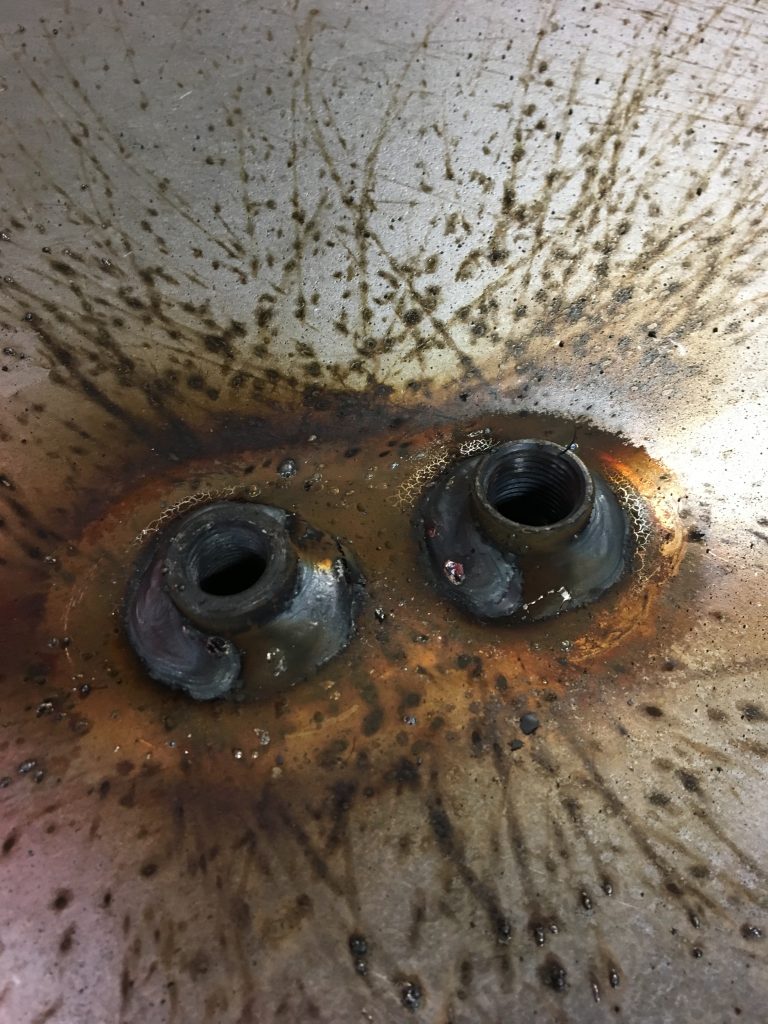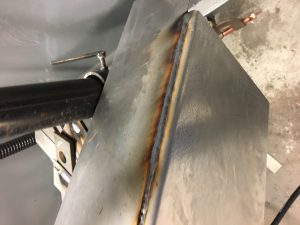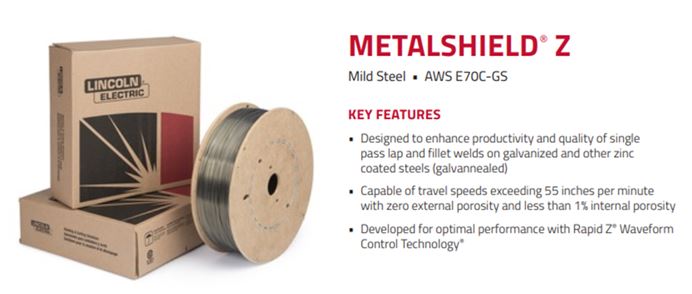Galvanizing is the application of a zinc coating to a ferrous material. It is done to prevent, or at the very least delay corrosion. The zinc coating can be applied in many different ways including but not limited to hot-dipping, metal spray and electrodeposition. Similar to galvanized steel is galvanneal steel. Galvanneal is the process of taking hot-dipped galvanized steel and passing it through a furnace to anneal the coating. This process causes the iron and zinc layers to diffuse into one another causing the formation of zinc-iron alloy layers at the surface.

The zinc coating on galvanized parts can produce excessive amounts of spatter. This problem can be resolved following basic recommendations.
Galvanized parts are used in a wide variety of industries including automotive, structural steel, construction, oil field and many more. It is a great process to prevent corrosion. The challenge is welding over the zinc coating.
The heat of the arc will burn off the zinc coating without problems; however, the resulting weld may present many issues such as excessive porosity, unacceptable bead appearance, lack of fusion, cracks and excessive spatter. Although the weld burns off the zinc, very little if any corrosion resistance is lost, especially in thin section (sheet metal). Porosity is almost inevitable and is affected mainly by the thickness of the zinc coating. Manufacturers of filler metal have come up with special wires that promise to eliminate porosity. This is a big claim and these filler metals certainly have some merit, but there are other practical ways to successfully weld galvanized steel. Below are a few recommendations on how to weld on galvanized steel.
Any Arc Welding Process – General Recommendations
The best way to weld galvanized steel, regardless of welding process, is to remove the zinc coating from the joint. This adds two operations: removing the coating and re-spraying or painting the weld seam after welding to regain corrosion resistance. In some cases the latter is done regardless of whether or not the coating was removed prior to welding.
Although it adds one or two operations it will eliminate or at least drastically reduce spatter and spatter clean up. It should also eliminate porosity, cracking and lack of fusion. In most cases, removing the zinc coating from the joint ends reduces overall costs because it also eliminates rework.
Another way to reduce the costs associated with removing spatter is to position the part in such a way that the spatter does not hit the part or rolls off it. In many cases this means you will be welding vertically with a downward progression. This should be limited to thin section as vertical down welding produces shallow penetration. The zinc coating makes is even worse. Do this on sheet metal only.
Keep in mind that removing the zinc coating can be as hazardous as welding over it. Always wear protective equipment and have adequate ventilation.
SMAW Process
- Use an E6010 electrode. E6011 is OK and recommended if you have an AC only power source.
- Use an inline whipping technique, the back and forth motion will help vaporize the zinc coating and prevent porosity and cracks.
- Use the largest electrode possible, especially in fillet welds on materials with thickness of ¼” or thicker. The zinc coating can prevent proper fusion. The larger the electrode the more amperage we can use. The higher the amperage the easier it is to fuse the root of the joint.
- The SMAW process will produce a lot of spatter, especially with the 6010 electrode. There is not much you can do about it other than find better ways to remove the spatter or prevent it from sticking. Anti-spatter can be applied before welding to minimize the amount of spatter that sticks to the part.
GMAW Process
- Use ER70S-6 or ER70S-3 electrode.
- For thin sections use short-circuit transfer. In thicker sections (3/16-inch plus) spray transfer may be used and can significantly reduce spatter.
- Use a shielding gas that contains at least 20% carbon dioxide, balance argon. The high carbon dioxide content does a good job of welding through the zinc coating. If using short-circuit transfer in thinner parts using 100% is acceptable but will generate more spatter. If you will use spray transfer then got with not less than 20% carbon dioxide.
- Spatter, porosity and cracks are the biggest concerns as they are with SMAW. However, with GMAW we have a few more options in terms of modifying the welding procedure. You can try different shielding gas mixtures (play with the CO2 content). You also have the option of using a silicon-bronze filler metal (AWS Classification ERCuSi-A). This allows you to weld at lower amperages creating a joint that mimics brazing. There is less admixture, meaning less zinc in the weld metal. This reduces the amount of porosity and reduces susceptibility for cracking.

It is possible to get spatter free welds on galvanized steel. Developing and following a qualified welding procedure is the first step.
FCAW Process
- Use a self-shielded electrode such as E71T-11. This electrode is essentially a stick electrode (SMAW electrode) turned inside out. It will produce slag and will not produce the most aesthetically pleasing weld, but it does a good job over galvanized.
- No shielding gas is necessary with this electrode, but running a 75% Argon – 25% Carbon Dioxide mix with it will help reduce spatter. Do not do this on structural components as the added argon can produce higher strength weld deposits which may increase hardness, reduced ductility and increase cracking susceptibility. Use shielding gas only on galvanized sheet metal parts.
MCAW Process
- Similar to GMAW, but use a metal-cored electrode (AWS E70C-6M).
- These electrodes run better with a 90% Argon – 10% Carbon Dioxide shielding gas.
- Some manufacturers have developed metal-cored electrodes that promise to eliminate or reduce spatter and cracking when welding over galvanized. Keep in mind that some if not all manufacturers of these electrodes state that in order to get the promised benefits you must run their welding power source.

Many filler metal manufacturers are addressing the problems associated with welding over zinc coatings through filler metals and welding power sources. This is a viable alternative but not the only way.
Safety Concern – In addition to the weld-related issues stated above (porosity, cracks, lack of fusion and spatter) there is a higher than normal risk to the welder due to the toxicity of vaporized zinc. You may be familiar with the practice of drinking milk when welding on galvanized. The intoxication caused by the vaporized zinc affects the stomach; the milk helps alleviate the discomfort, but does not eliminate the toxic effects. It is imperative that proper ventilation is used to protect the welder and those around him or her.
Reference: The Procedure Handbook of Arc Welding – 14th Edition

Very informative guide and the process are well described. Very beneficial.
Thanks
Very well explained and just what I needed. Rich content. Good job.
Good article, I used to work in a sheetmetal shop and when we had a big galvanized job the company would supply us with milk in the morning. lol. I can’t remember why, but I always preferred using 6011 down hill. We have at times silicon bronze welded with a type of carbon arc and with GTAW.
Thanks again , Dennis
You are very welcome Dennis. E6011 works great. Always a great choice especially out in the field. Carbon arc is certainly another process, personally I have never seen it done so I kept it off the article. Maybe I’ll research it a bit and add to it. Can you share your experience with it?
Do you have an email that I could send a video to? and I’ll try to make a short clip of the process. I’m very appreciative of like minded people on welding and I do enjoy your articles. I believe that you have my email.
Hi Dennis, please send it to info@weldinganswers.com
I Meant SMAW stinger holding the carbon rod. Just read what I typed.lol